After the seminar on essay writing this week I spoke briefly to Alice who told me that she’d come across an artist called Alma Haser whose work I might be interested in, she deals with image manipulation using primarily physical methods.
I went into the library before the afternoon session on Typography to see if I could see any work that might inspire me and to see if I could see anything by Haser. The library catalogue showed a brief article on Haser in a Wired magazine from Feb 2012 but I couldn’t find it in the periodicals section.
I’m sure it’s there but I was reading an edition of The British Journal Of Photography (BJP) and another of Aperture so thought I’d find the Haser article online later.
In the Wired article “Exquisite Origami…Made out of human faces” dated 10th April 2016 by Jenna Garret it goes into how Haser came about combining her photography with origami. The ancient art of paper folding was an interest of Haser whilst she was at Nottingham Trent University studying Photography and only after completing her studies did she begin mixing the two subjects.
Originally born in Germany but spending most of her life in the UK she creates images that cause the viewer to question what they’re seeing. Her About page on the website haser.org states
“Expanding the dimensions of traditional portrait photography, Alma takes her photographs further by using inventive paper-folding techniques, collage and mixed media to create layers of intrigue around her subjects; manipulating her portraits into futuristic paper sculptures and blurring the distinctions between two-dimensional and three-dimensional imagery. “
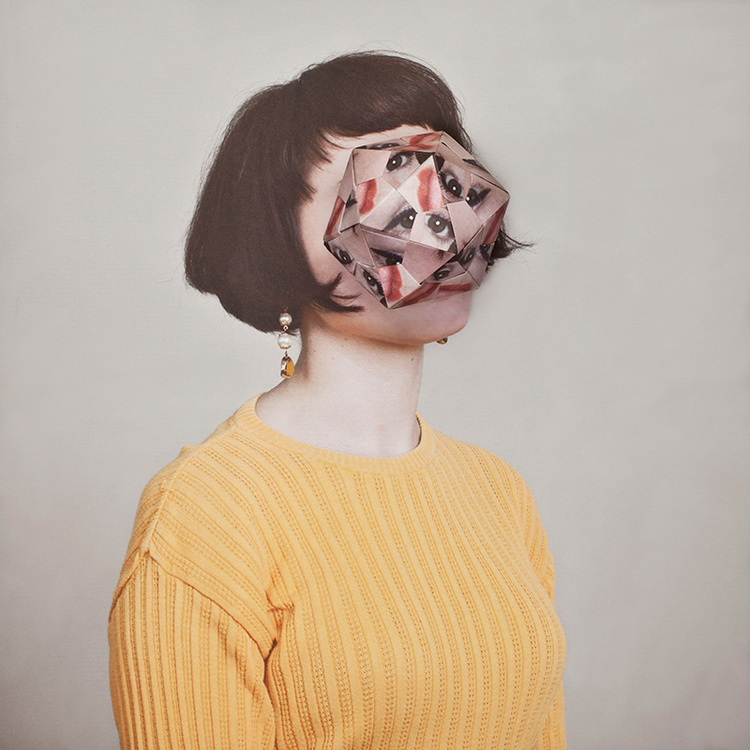
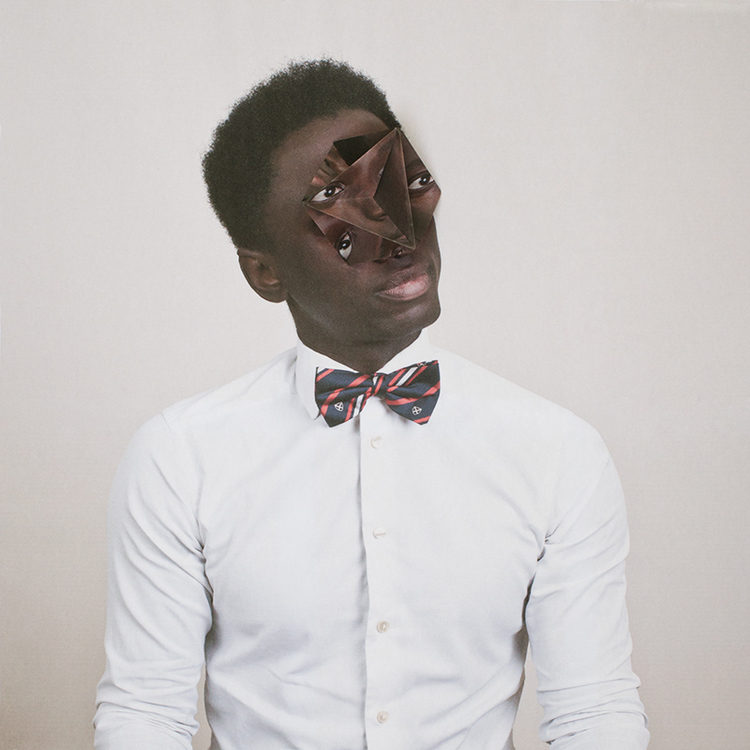

Looking at some of her work in this Cosmic Surgery reminds me of a piece of work I created at the end of November ’22 when I was printing an image of some mailboxes on a white wall with their shadows. I decided that I was going to try and change the paper under the enlarger, whilst it was sat on the easel. I set up the shot and created a print, after a good few tries, the exposure was a pain and I still wasn’t 100% happy.

The next sheet of Ilford MGRC I put on the easel was then folded into an origami piece, originally it was going to be a “water bomb” that I used make in school, but then somehow it ended up as the school playground “Fortune Teller”. You know the things that you put your hands under, ask someone to pick their fave colour, then a number and when the requisite number of back and forth motions have completed, the flap is opened to alert you to the fact that you were going to marry your best mate’s mum, or other slurs that I wouldn’t be tempted to quote in today’s society.
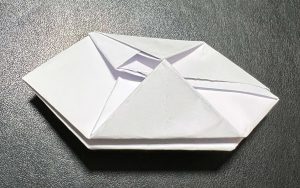
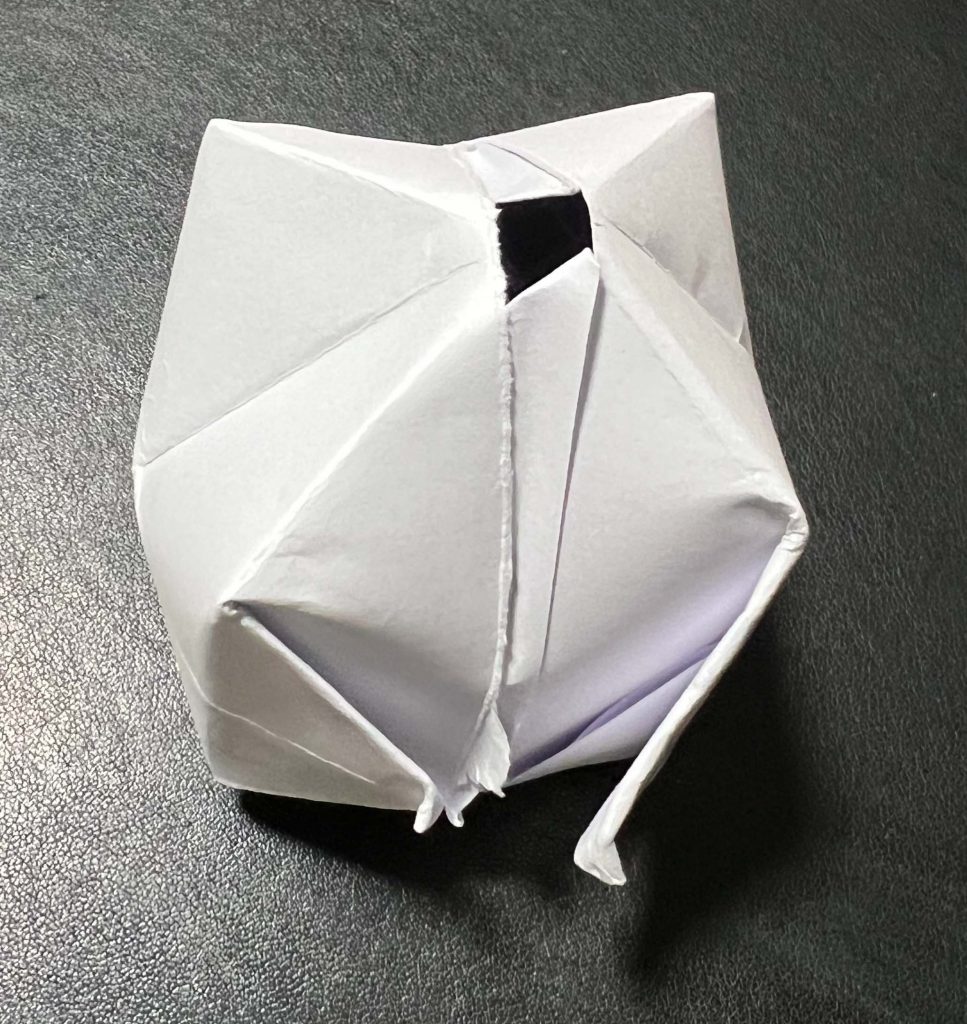
I placed the folded paper on under the lamp for the same period as the original print and then when I took it off, I unfolded it, developed, stopped, fixed and then dried it.
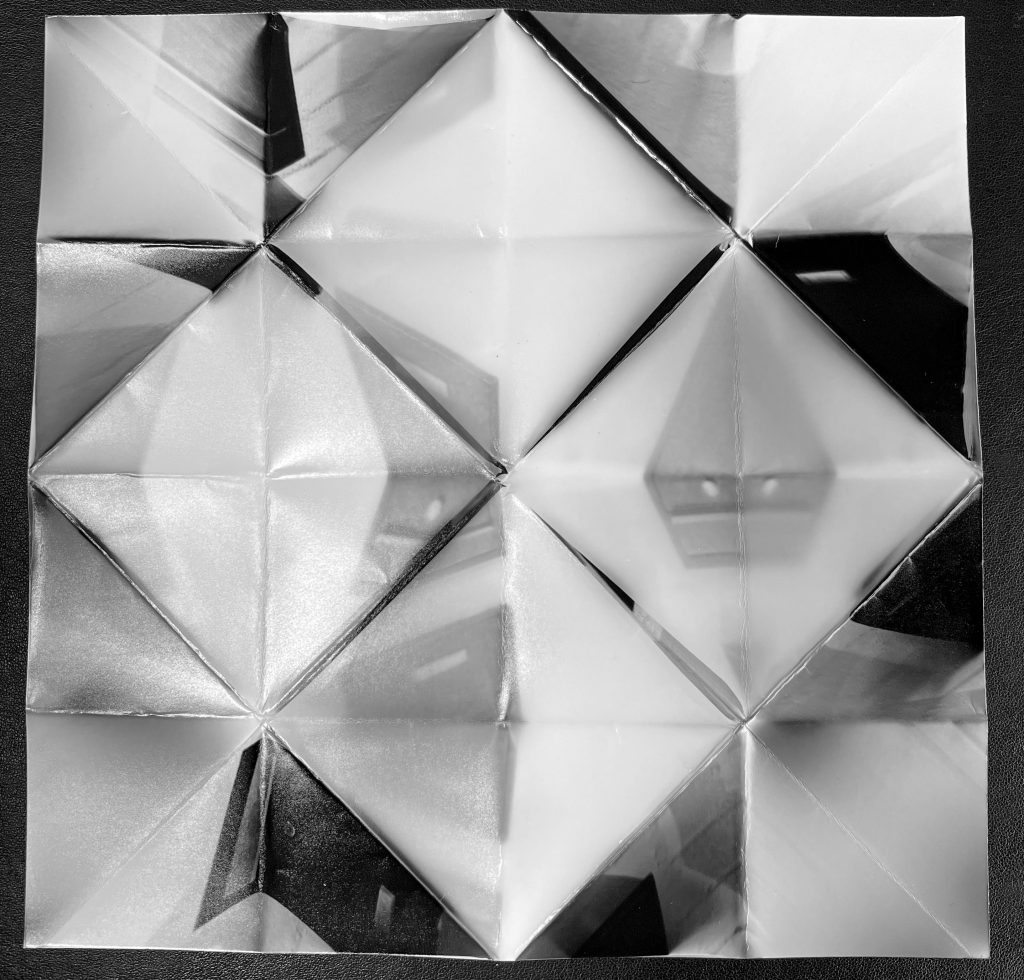
When I took it into the light to examine I was not surprised to see the strange representations therein.

In Haser’s work “Cosmic Surgery” she printed one image of a portrait, sometimes self portraits, and then printed out multiple smaller images of the face from the portrait, before creating an origami sculpture from this and placing it on the face of the main portrait. She says on her website that she doesn’t like her face being the subject of her self portraits and searched for ways to create a mask and this origami was ideal. She used process to create many different images that are all interesting and ask the viewer to figure out what it is they’re looking at.
Repeat
In one of her other projects, titled “I always have to repeat myself” she experiments with some weaving as I’ve done already too. In Haser’s work though it looks like two images taken at a similar time and with each image being a combination of the two. In a BJP Article she is quoted as saying.
“Everything I do is unknown, I never know exactly how I’m going to produce the work until I’ve spent hours experimenting. Most of the time it’s a happy accident that shapes the final piece.”



I like that the images are not completely interpolated with each other and that only some sections have been played with, some of this is like the work of Jason Chen which I researched in this earlier post . The image on the left seems to be showing an image of a woman sat at a table with a dead Thrush (songbird) in her hands and alternately on the table top. The strips Haser has chosen to replace show a disembodied head lying on the table next to the dead bird as if grief-stricken at the loss. The upright figure now totally faceless appears to be holding the front of her severed face and strikes me as an image about loss, but I’ve not yet found any explanation as to what this represents to the artist. The third photo above seems to show the subject in two minds literally. It’s like a slow form of motion blur with the woman in the photo having two different facial expressions simultaneously and speaks to me of a schizophrenic nature, or someone who is one person usually and then becomes someone else. It reminds me of the lyrics from Avril Lavigne’s Complicated
Complicated by Avril Lavigne 2003“And if you could only let it be
You will see
Somebody else
‘Round everyone else
You’re watching your back
Like you can’t relax”
Puzzling
Also going back to some of my earlier ideas of what I could do to mix up images, I’d considered jigsaws, thinking of Dave Gorman and Tim Klein. Whilst traversing across Haser’s website I came across a project titled “Within 15 Minutes” which embraces that artists fascination with identical twins. She uses portraits of these monozygotic (from the same egg) siblings to print two jigsaw puzzles with the same die cut pattern and then swaps every other piece from one to the other, creating two jigsaws each showing aspects of both twins. It’s a wonderful use of the mechanism to try and highlight the differences between the identical twins.
The title “Within 15 Minutes” is the average time taken between the birth of the first twin and the second. For me it represents a combination of the genetics that are already combined, if this were some sort of statistical maths it’ might be almost another averaging process to find the person that exists when two identical twins are merged. On her website page for this project she refers to the fact that although the twins appear identical, there are still differences, such as the fingerprints being different due to the factors surrounding the gestation in the womb during the pregnancy. These works to me seem to be highlighting all of the differences even if they appear in the picture due to model placement or difference in expression or clothes.
I remember going to school with a pair of twins who did appear to get tired of being dressed the same and treated exactly the same by everyone they met when together. It must be tiresome sometimes going through life like that and not being able to change it, so I guess this is to help the viewer understand that each twin is an individual.
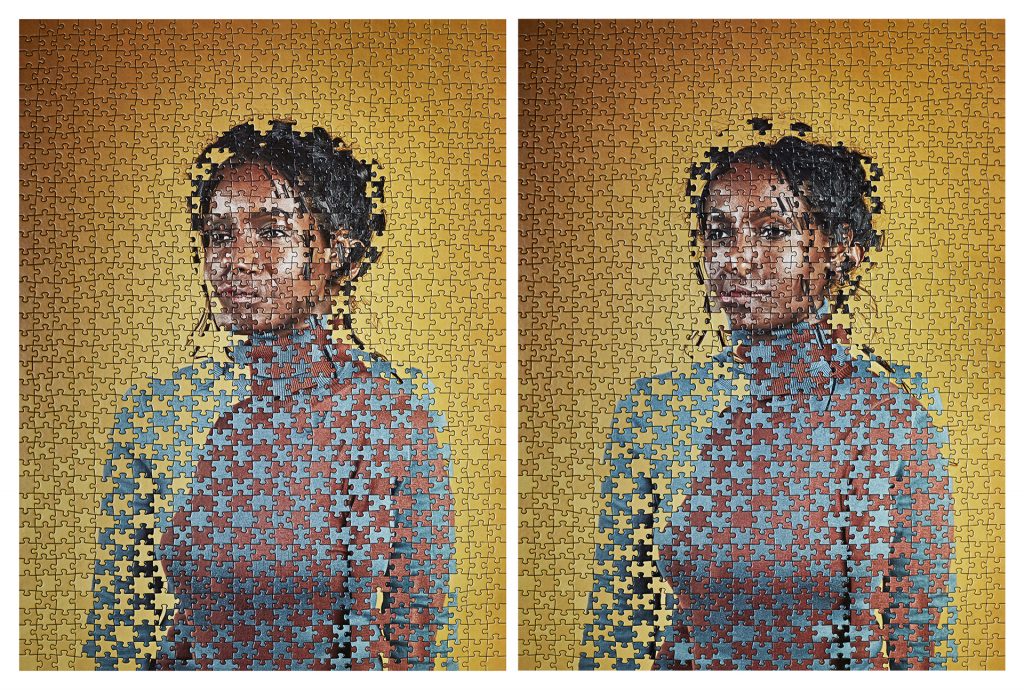
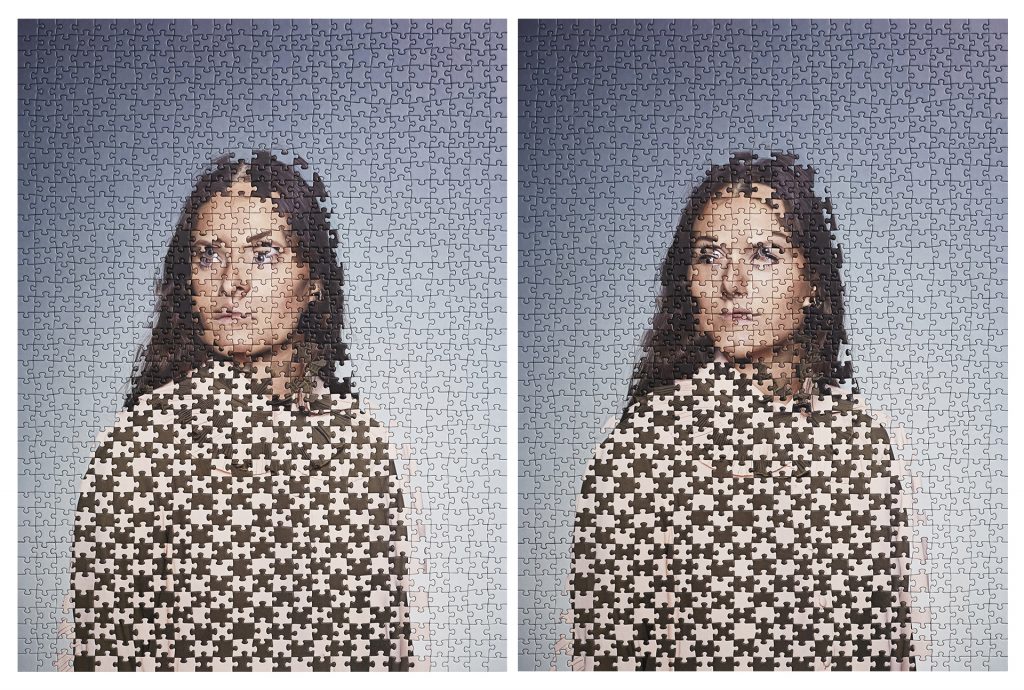
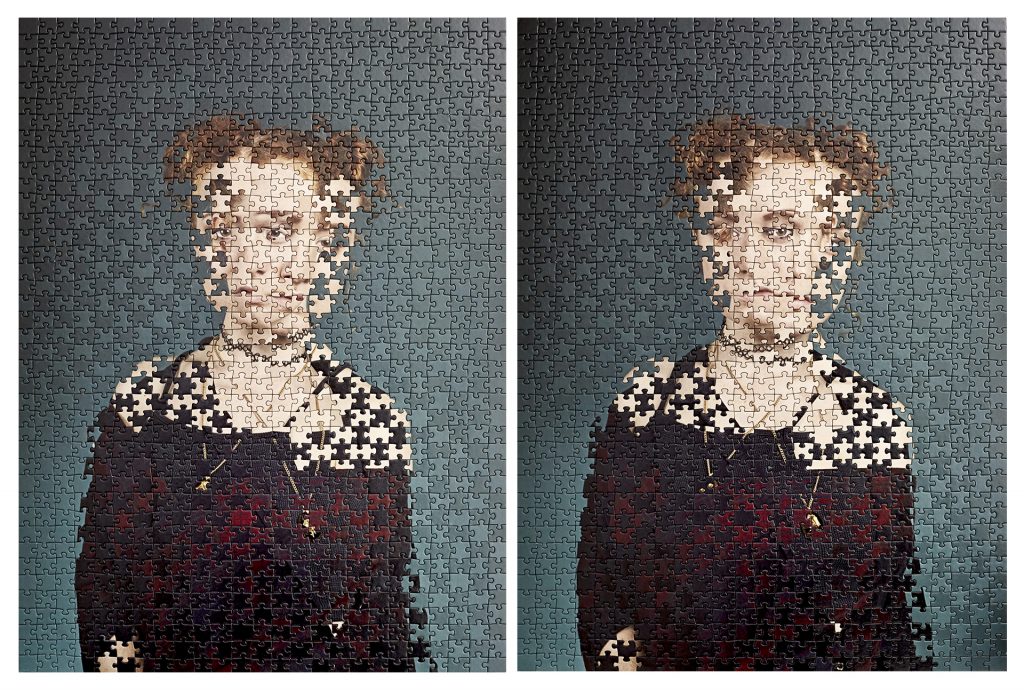
In my work, The Front and Back Of My Head I also merged two photos together in a checkered pattern which is what this jigsaw method is reminiscent of from a distance. Only when examined a little closer is it apparent that this is a mixture of two puzzles.

In some of her other work, available to see at her website, she plays with what is real and what is not, riffing on the “Fake News” zeitgeist that currently exists in today’s society after Trump and Pandemic. The work is interesting and useful to investigate but I’ve not included it in this blog post.
Ten Seconds To Comply
Alma Haser’s Youtube Channel shows her making the book and also a Ten Second Project which was inspired by this video of herself and her brother playing hide and seek in 1992. She can be seen playing freely in an artists studio and this must have rubbed off on her.
The Ten Second Project sees people set up a video camera next to a stills camera, set the timer to 10 secs and then run and play hide and seek in the image. It’s another interesting piece of work which comprises of nearly one hundred videos of people setting the timer and then hiding in the frame. Some of the stills featured on the facebook page are quite vexing as it’s difficult to spot the person, but in the main the subjects are hidden as though a child is covering their eyes so they are now invisible. It’s a childish bit of play but also makes for an intriguing watch.
It’s not really related to my current work but could be an inspiration and not something I’ve ever come across before so it is now in my reticular activation system ready to spot similar opportunities that I might be able to utilise in my own practice.
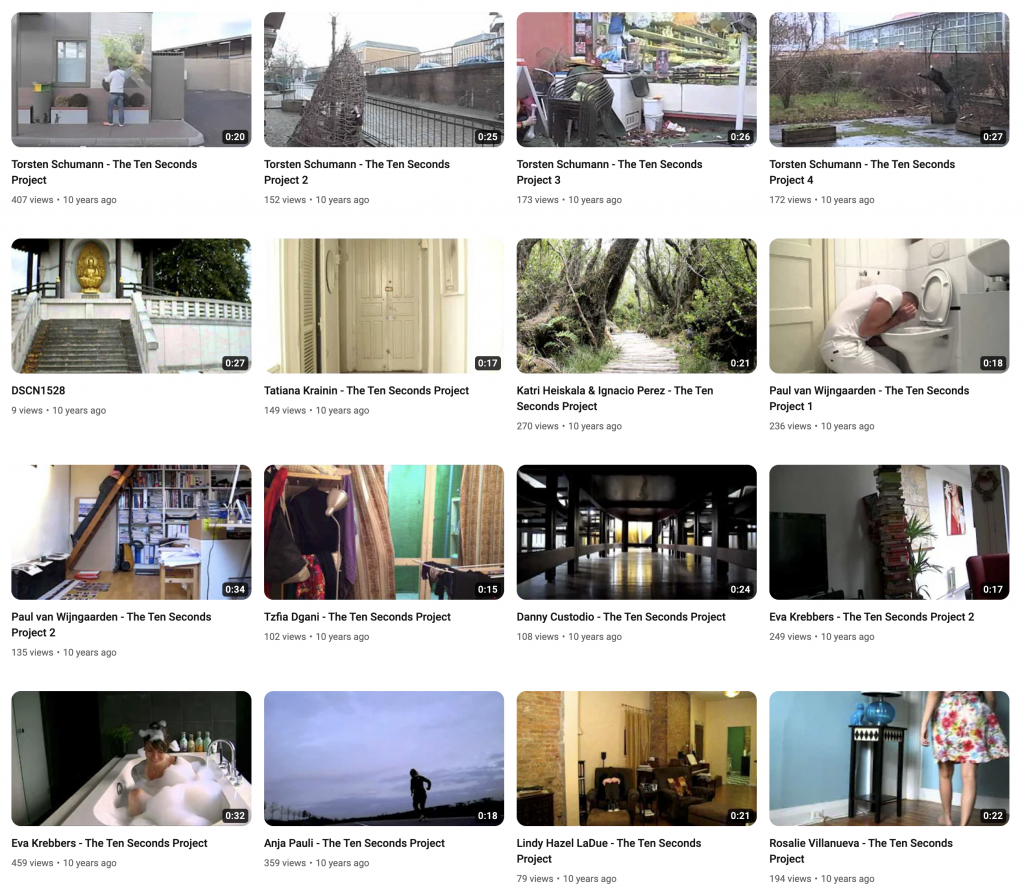
Reflecting on this Research
In terms of reflecting on this piece of research I will refer to Gibbs’ Reflective Model we studied in Week 8
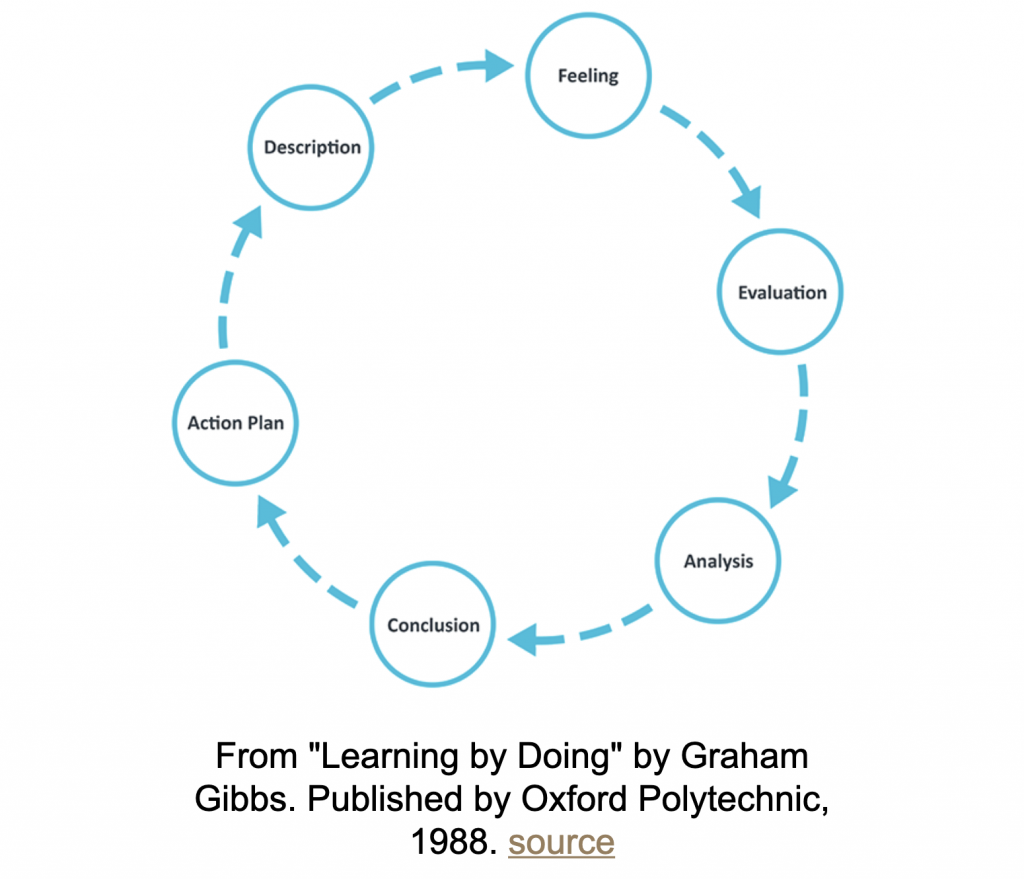
.
Starting with the description, i set out to research some of the work of Alma Haser after Alice had pointed it out to me. Some of the work seemed to fit in with my current practice and experimentation. I was going to write a blog post on the research I discovered about the photographer/artist so that I could return to it later and maybe incorporate or appropriate some of the work into my own work.
Feelings when I was carrying out the research were a mixture of motivation and procrastination mode. I’d watched an episode of Ghosts before sitting down to get on with this work but as happens, all too often, I get a bit side tracked with the YouTube rabbit hole. I was feeling motivated later and got on with some as I know it’s importance.
My evaluation of the session was a mixed bag also, I got some good research under my belt, coupled with some good information from the artists website and magazine articles but I felt that some of it wasn’t really linked to what I’m doing.
The Analysis of the research is something I’ve not done formally before so I’ve thought about all the steps that went into the making of this post, all of the time I’ve spent on it and all of the resources I’ve used too. This will take some getting used to I think.
To conclude before the action planning stage, I’d say that I need to be more focussed and have more passion to get the research tasks done. It’s already something that I do, I spend ages watching videos, documentaries, reading books and articles, but I just don’t document them all. It’s been easier to get the information down in this format that getting into my sketchbook so it may be a good thing to continue.
The plan of action for going forward will be to develop a list of artists I need to research, set some time aside in my calendar and then hammer away at them to delve deeper into their back catalogues as I’ve done here with Haser, and in the past with Wong, Killip etc.
The list of artists I need to research is:
- Greg Sand – Weaving images
- John Stezaker – found Image collages
- Thomas Kellner – Contact sheet mosaics
- Marc Austin – Lecturer who glitches images with databending
I will set a night aside for each of these topics and see where it goes. Look out for it on here but I will also print out some of the images I refer to and stick them in my sketchbook as a visual reminder in a practical form.
[…] of one image with another to produce another type of image. More research into this can be read in this post and some previous posts […]
[…] called Alma Haser, that might be worth looking into. Haser had a really interesting project with jigsaws and identical twins as well as some origami methods to create weird and wonderful effects. I did also buy some jigsaws […]
[…] Along with this I have two jigsaws to make, print out two images and glue to the jigsaws before cutting them apart with a scalpel and then swapping parts of one with another as I discussed in this post. […]